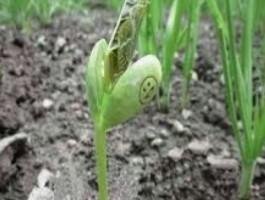Waiting for the process: Three magic beans
Growth is a process of increasing the size (including volume, height, mass) and is irreversible, or can not return to its original form. Development is an event of biological change to maturity can not be expressed by size but with changes in body shape (metamorphosis) and maturity level. Growth and development are two life activities that can not be separated, because the process runs simultaneously.
Small plants, recently emerging from seeds and still living from the food supply contained in the seeds, are called sprouts (plantula). Beginning of germination begins with the end of the dormancy period. Seeds can germinate because they contain embryos or plant institutions. Embryos or plant institutions have three parts, namely the root of the institution / root candidate (radikula), the leaves of the institution (kotiledon), and the stem of the institution (kaulikulus).
If I had 3 beans, I would try to seed the 3 seeds in different pots by putting them in different temperatures. I will learn which bangai process of growth of the three sprouts from the three seeds of peanuts, whether later there is a difference produced bean sprouts that print with different temperatures and light ..?
Because growth is an irreversible volume increase process due to mitotic division or cell enlargement, it can also be caused by both. Growth can be measured and expressed quantitatively (calculated by number). While the development is terspesialisasinya cells into a particular structure and function. Development can not be expressed by size, but can be expressed by changes in form and maturity level.
Growth and development in plants begins with seed germination. Then, the sprouts develop into a perfect little plant, which then grows enlarged. After reaching a certain period the plants will flower and produce the seeds again.
Germination is the appearance of plumula (small plant from inside seed). Based on the location of cotyledons, germination is divided into 2, namely epigeal and hypogeal. Epigeal germination is in the event of stem opposition of the stem underneath the institute or hypocotyl leaves, causing the leaves of the institution and the cililiden to rise above the ground, such as green beans. While hypogeal germination is in the event of the opposition of the top stem (epicotil) so that the leaf of the institute is involved in the soil, but the cotyledon remains in the soil, for example in the peanut seeds.
Germination is characterized by the appearance of sprouts, ie small plants and still alive from the supply of food that is in the seeds. There are four important parts of the seed that germinate, namely the stem of the institution (kaulikulus), the embryonic root (the root of the institution), the cotyledon (institute leaf), and the shoot of the institution (plumula). Kotiledon is a food reserve in sprouts because at the time of germination, plants have not been able to do photosynthesis. Water is an absolute necessity for germination. The first stage of germination is rapid water absorption in an imbibition manner. The aerated water causes the seed to expand and break the skin of the wrapper and also trigger the metabolic changes in the embryo so that the seeds continue growth. The enzymes will begin to digest the stored materials stored in the cotyledons, and their nutrients are transferred to the growing embryo. Enzymes that play a role in the digestion of food reserves are enzyme amylase, beta-amylase and protease. Gibberellin hormone plays an important role for the activation and synthesis of these enzymes.
Germination of seeds there are two kinds of epigeal and hypogeal. Epigeal germination is a germination that causes cotyledons to rise above the ground. This is due to the growing hypocotyl lengthwise. As a result, plumules and cotyledons are pushed to the soil surface, for example in the germination of green beans (Phaseolus radiatus) and peanuts (Arachis hypogaea). While hypogeal germination is germination which causes cotyledons to remain embedded in the soil. This is due to the elongated growth of the epicote which causes the plumula to pass through the seed shell and appears on the soil, whereas the cotyledons remain in the soil, for example in the germination of peas (Pisum sativum), corn (Zea mays), and rice (Oryza sativa) .
I strongly support the vision and mission undertaken by: @the-reef

Approved
@the-reef
Another #whalepower Curator / Moderator Account
Awesome!
A very scientific explanation....
And of MAGIC BEANS at that!